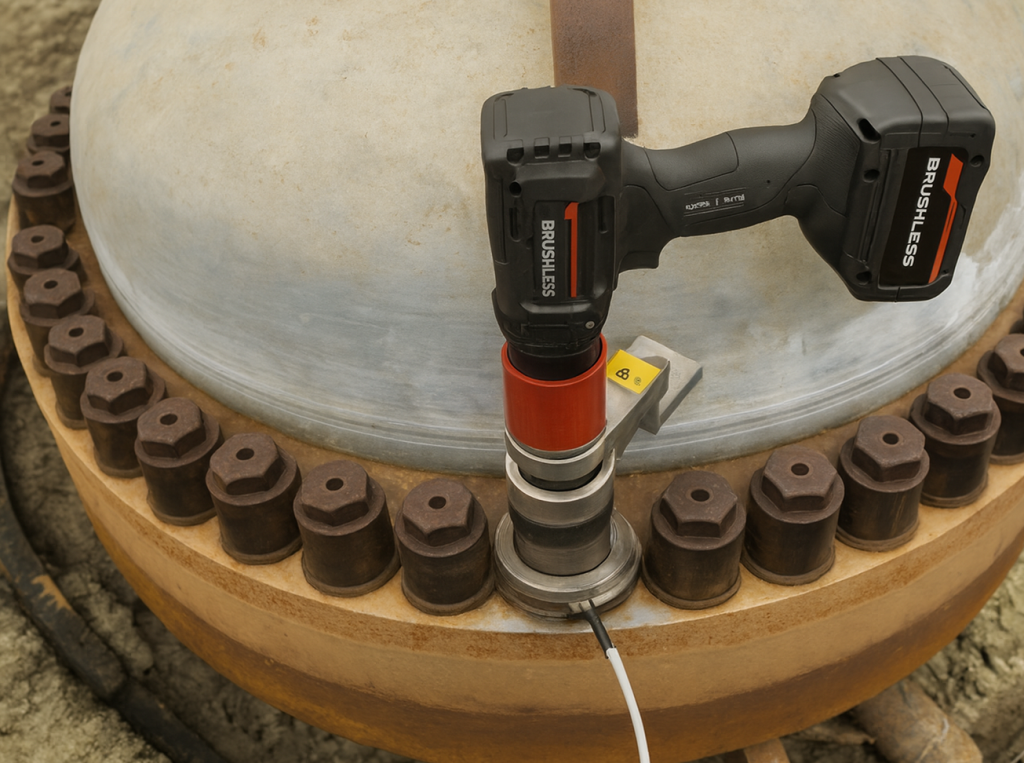Critical flange connections are found wherever media are transported under pressure, high temperatures or in safety-relevant environments. In industries such as chemical processing, energy and mechanical engineering, reliable sealing is essential for operational safety.
One of the biggest challenges is knowing the actual force acting on the flange. In most cases, only the torque applied to the bolts is measured, but torque is not equal to force. There are several methods to estimate bolt preload, such as torque-based calculations or elongation measurements. However, these are indirect and often influenced by friction, surface conditions or assembly errors.
To ensure that a flange connection remains tight under all conditions, the real bolt preload must be known and controlled. Hydraulic load cells provide a direct and practical way to measure this preload accurately during assembly and operation.
We provide specialized services for measuring, analyzing and documenting bolt preload in critical flange joints, helping to verify the integrity and sealing performance of these connections.
Torque vs. Force – The Crucial Difference
When a bolt is tightened, torque is applied to generate preload. However, only a small portion of that torque becomes axial bolt force, which holds the flanges together.
Most of the energy is lost due to friction between threads and under the bolt head. Factors such as unlubricated bolts, dirty surfaces or improper washers can drastically change friction and thus the achieved preload.
Even if the torque value is correct, the resulting bolt preload may differ significantly. Too little preload leads to leakage, while too much can damage the gasket or deform the flange.
Hydraulic Load Cells – Function, Benefits and Applications
Hydraulic load cells are installed like thick washers between the bolt head and the flange surface.
As the bolt is tightened, axial force creates pressure inside the cell, which is then measured and converted into a force value via a scale or electronic sensor.
This allows for a direct and accurate measurement of the bolt preload, independent of friction, thread condition or surface roughness.
Key Benefits
- Direct measurement of actual bolt preload
- No dependency on torque or friction
- High repeatability and reliability
- Easy integration during assembly
- Digital data acquisition for documentation
Load cells are used both proactively and diagnostically in flange technology.
During development or quality control, they help determine how tightly a gasket is sealed and how the clamping forces are distributed across the flange. This provides valuable insight into the relationship between bolt preload, gasket compression and sealing performance.
In field applications or troubleshooting, load cells quickly reveal uneven bolt tension, loss of preload or incorrect assembly, allowing engineers to detect and correct issues without guesswork.
By placing load cells at several bolt positions around the flange, engineers can visualize the complete load pattern and ensure uniform gasket compression, a key factor for long-term sealing reliability.
They can even help identify early-stage leakages: a drop in measured preload over time indicates gasket relaxation or bolt settlement long before any visible leakage occurs. This early detection enables proactive maintenance, increasing both safety and reliability.
Our Expertise
We specialize in measuring and documenting bolt preload in critical flange connections.
With hydraulic load cell technology, we accurately determine clamping forces to identify uneven load distribution, detect potential leaks and verify assembly quality.
Contact us for consultation on critical flange sealing analysis.



